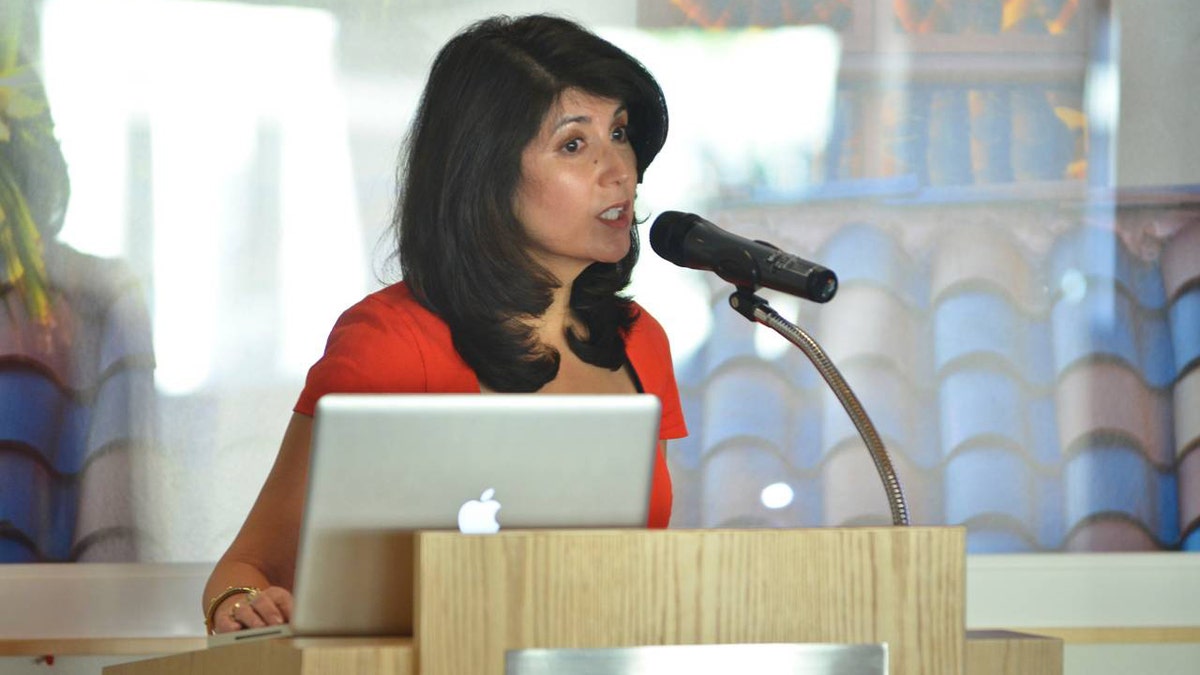
Margarita Quihuis at the Stanford Business School, Dec. 14, 2013. Photo: Rod Searcey.
Margaret Quihuis’ business is peace. And innovation. And peace through innovation.
And business is, well, booming.
Quihuis, 51, is the co-director of Stanford University’s Peace Innovation Lab, a research initiative that develops “quantitative, predictive, computational systems and methods to sense engagement levels and interaction quality across group boundaries,” according to the Lab’s website.
“We examine social networks,” Quihuis explained much more sensibly to Fox News Latino recently, “to see if they can be used as a baseline for measuring peaceful interactions.”
So, for instance, one of their projects measured over time the Facebook “friends” who crossed Israeli-Palestine lines. Whenever there is a flare-up of violence between Israel and the Palestinian-controlled territories, “There may be a dip in new Israeli-Palestinian declarations of friendship, but it doesn’t go to zero. It doesn’t even go to half," Quihuis said.
Of course, she admitted, “It’s hard to check causation. Statistically speaking, life is noisy.”
The daughter of a Mexican-American construction worker in a suburb of San Diego, Quihuis grew up in an environment of social change.
“We had people in the family who were in the Chicano Federation” – a group that, at the time, worked for social justice for Mexican immigrants. “My dad was the first Hispanic supervisor in his company,” she said with a proud tone.
Quihuis’ father also developed some fairly rigid ideas about what profession his daughter should go into. “Sometime in the 1970s, he read an article saying that engineering was the wave of the future,” she said, amused. “It was really just about which career paid the most. It’s funny how people read things in the newspaper and think it has the authority of the Gospels.”
So Quihuis enrolled in Stanford and graduated with a degree in petroleum engineering. “I worked for Getty on the production side in Bakersfield, Calif. There weren’t many Latinos,” she recalled. “Much less women. It was definitely the land of paternal sexism.”
Dissatisfied with life in the oil fields, she tried to break into the world of entrepreneurship but was shocked by the severe limits on capital that were accessible to women and people of color, even in the comparably progressive world of Silicon Valley.
“It became clear to me that it was all about social networks,” she told Fox News Latino. “It was affinity-based, with the money going to people who were already known to the people in charge of distributing the capital – they had gone to the same school or been in the same fraternity.”
In fact, between 1991 and 1996, according to a study funded by Wells Fargo bank and the National Foundation for Women Business Owners, women received 1.6 percent of the roughly $33.5 billion invested in tech companies.
So she decided to take on the problem. Quihuis launched a women’s VC network called 1st Wednesdays, and in 1999, she became the founding executive director of the Women’s Technology Cluster (now called Astia), which was headed by Cisco System’s Cate Muther and advised female entrepreneurs how to break into existing networks and create their own.
“That was one of the first significant efforts in Silicon Valley to get people with access to venture capital to go outside their comfort zones,” she said.
In the mid-2000s, she left the Technology Cluster — “it was enough for me to have birthed that baby" — to pursue her own entrepreneurial ideas.
One such venture involved doing something with remittances that moved every year from California to Mexico. “The amount of money exceeded foreign direct investment,” Quihuis pointed out.
She started Indigo Financiera, which produced an ATM-like card that allowed Mexican immigrants to send remittances back home.
“There was a bit of a timing issue with that,” she said. “In 2013, after the advent of smart phones and payments from mobile devices, it seems more natural. But back then, with consumer habits as they were and security concerns and the large number of remittance corridors, you needed to have a lot of partnerships.”
The remittance company struggled for a while, but has endured under other names (m-Via, Boom). In 2009, however, Quihuis took her relentless drive for innovation back to Stanford, as a researcher in the Persuasive Technology Lab — a sort of think tank for technology and innovation that helped spawn Instagram — where she helped found the Peace Innovation Lab.
“We look at technology and innovations and try to determine how they can be used to advance peace,” she said.
Asked for examples, she mentioned: “Citizen-diplomacy efforts on social media where official ones have failed, crowdsourcing new constitutions for countries like Egypt and Tunisia.”
It may seem strange for such a restless individual so focused on innovation, but Quihuis stresses that part of the process is patience and seeing what happens, a sort of trial-and-error business approach.
“The Newton and the Palm Pilot looked cool once upon a time,” she pointed out. “Facebook was the ninth social network to be launched. The network effect means that it can take a few years for a radical technology to really take hold.”
